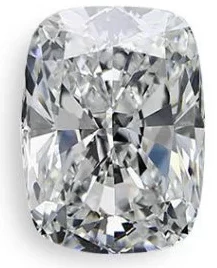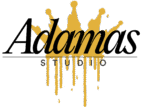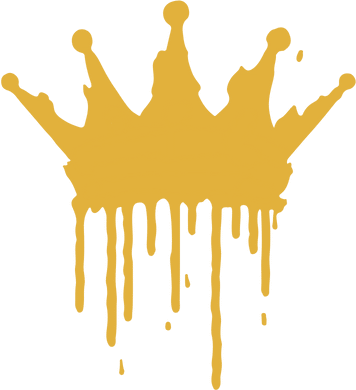
Gabrielle’s Ideals for Elongated Cushion Diamonds
(Table: 59–65% (59%–61%), Depth: 65–69% (64% hard limit, 70% hard limit), Pavilion Depth: 47–56% (49-53%), Pavilion Angle: 40–41° (40.2°–41.25°), Crown Angle: 30–45° (steeper the better for crown), Crown Height: 12–15%, Girdle: 2.5–4.5%)
The elongated cushion cut diamond is a refined variation of the classic cushion cut, offering the same soft, pillowy shape but in an extended, elegant form. Designed for those who love the balance of vintage charm and modern elongation, the elongated cushion maximizes finger coverage and fire while maintaining the rounded edges that make it durable and timeless.
The traditional square cushion cut itself dates back to the 1700s, originating from the Old Mine Cut, a predecessor to modern brilliant cuts. However, the elongated cushion cut emerged as a contemporary evolution, designed to provide greater face-up size and a more distinctive, elongated silhouette while preserving the cushion cut’s signature brilliance. It gained popularity in the early 21st century as diamond cutting technology improved, allowing for precise faceting that enhances both fire and brilliance in this unique shape.
1. What Is an Elongated Cushion Lab Diamond? #
An elongated cushion lab diamond features a modified cushion with a brilliant facet arrangement and a more stretched, rectangular appearance. Its gently rounded corners and extended length differentiate it from the standard square cushion, uniquely balancing vintage warmth and contemporary elegance. The interplay of its table, depth, pavilion, and crown is engineered to maximize light return and create a striking, elongated visual impact.
Why Choose an Elongated Cushion Cut Diamond?
-
Balanced Elegance:
Combines the soft curves of a cushion cut with the elongated proportions of an oval, creating a graceful silhouette.
-
Exceptional Fire (Rainbow Light Dispersion):
Cushion cuts excel in fire, meaning they display strong rainbow flashes in the light.
-
Maximizes Finger Coverage:
The elongated shape covers more surface area, making the diamond appear larger than a square cushion or step-cut diamond of the same carat weight.
-
Durable with a Vintage Feel:
The rounded edges prevent chipping, making it more resilient than princess or radiant cuts.
-
Versatile & Unique:
Works well in both modern and vintage-inspired settings, offering a balance between classic and contemporary aesthetics.
Potential Downsides of an Elongated Cushion Diamond
-
Proportion Sensitivity:
It is crucial to achieve the perfect balance in an elongated cushion. Minor deviations—such as an oversized table or incorrect depth—can lead to reduced fire and diminished brilliance.
-
Bow-Tie Effect:
Some elongated cushion cuts may exhibit a bow-tie effect—a subtle dark area across the center—if the cut is not executed to ideal specifications, potentially detracting from the overall sparkle.
-
Depth Can Reduce Face-Up Size:
A poorly cut elongated cushion cut can often be deeper than other elongated shapes, meaning they can face up smaller than ovals or radiants.
-
Inclusion Visibility:
If clarity or the cut is less than optimal, inclusions may become more noticeable than other shapes, sometimes necessitating higher clarity grades.
2. The 4Cs for an Elongated Cushion Lab Diamond #
While the 4Cs—Cut, Color, Clarity, and Carat—are essential for every diamond, the cut is paramount for elongated cushion diamonds, as it directly influences their light performance.
Cut – The Heart of Elongated Cushion Brilliance
Getting the cut right means dialing in those key proportions:
-
Table Percentage (IGI’s ideals: 59–65% | Gabrielle’s Ideals: 59–61%):
The table is the primary facet where light enters the diamond. Maintaining this range ensures even light distribution, enhancing both fire and brilliance.
-
Depth Percentage (IGI’s ideals: 65–69% | Gabrielle’s Ideals: 64% hard limit, 70% hard limit):
Depth defines the overall height of the diamond relative to its width. An optimal depth allows light to bounce effectively within the stone, maximizing sparkle while preventing light loss.
-
Pavilion Depth (IGI’s ideals: 47–56% | Gabrielle’s Ideals: 47–56%):
The pavilion is where internal reflections occur. Proper pavilion depth directs light back through the crown, contributing to exceptional brilliance.
-
Pavilion Angle (IGI’s ideals: 40–41° | Gabrielle’s Ideals: 40.2°–41.25°):
This angle guides the light through the diamond, playing a crucial role in balancing brilliance and scintillation.
-
Crown Angle (IGI’s ideals: 30–45° | Gabrielle’s Ideals: steeper is better for crown):
The crown angle is key for dispersing light into its colorful spectrum (fire) while ensuring overall brightness. A steeper crown often enhances the fire.
-
Crown Height (12–15%) & Girdle (2.5–4.5%):
These factors contribute to both the stone’s durability and its visual appeal, ensuring the diamond withstands everyday wear while performing at its best.
Pro Tip: Cushion cuts come in different faceting styles—for a more structured sparkle, choose chunky facets over crushed ice.
Color – Enhancing the Icy Sparkle
Elongated cushion diamonds are cut to reveal a bright, white appearance. Selecting the right color grade enhances their natural sparkle:
-
D–F (Colorless): Provides a pristine, icy-white look that maximizes brilliance.
-
G–H (Near Colorless): Offers an excellent balance between value and that sought-after white radiance.
-
I–J: May introduce a subtle warmth—ideal if you plan on setting your diamond in yellow or rose gold, which can complement and balance the tone.
Pro Tip: For settings in yellow or rose gold, an H–J color grade works well, as the metal helps mask any slight warmth.
Clarity – Focus on Structural Integrity
Lab diamonds generally feature fewer inclusions than natural stones. For elongated cushion diamonds, aim for eye-clean clarity to ensure nothing detracts from the stone’s luminous performance:
-
VS1–VS2: The sweet spot—providing excellent clarity and value without visible inclusions.
-
SI1–SI2: Acceptable if any inclusions remain invisible to the naked eye.
-
VVS1–VVS2: Nearly flawless, though these stones come at a premium.
-
F–IF: Flawless diamonds exist but are generally unnecessary for most buyers.
Pro Tip: A VS1–VS2 clarity elongated cushion typically strikes the best balance between beauty and affordability.
Carat – More Size for Your Budget
Due to their depth, elongated cushion cuts tend to face up larger than square cushions but smaller than ovals or radiants.
Pro Tip: If maximizing face-up size is the goal, opt for an elongated cushion with a slightly shallower depth within the ideal range.
3. Additional Considerations #
Symmetry & Polish
-
Symmetry: Excellent symmetry ensures the diamond reflects light evenly for an elegant, well-proportioned appearance.
-
Polish: Excellent or very good polish is the best choice to maximize the crispness and cleanliness of the facets.
Fluorescence
-
None or Faint fluorescence is best—strong fluorescence may cause haziness in some stones.
Certification
-
Always buy IGI- or GIA-certified diamonds to ensure accurate grading
Setting Considerations
-
Metal Choice: White gold or platinum enhances the icy brightness of an elongated cushion diamond, while yellow or rose gold can add a touch of warmth.
-
Setting Style: Prong settings maximize light exposure, ensuring that every facet contributes to the stone’s stunning sparkle.
Final Thoughts #
Elongated cushion diamonds offer a unique blend of classic cushion charm and modern elegance. Their extended, refined silhouette, paired with a cushion brilliant facet arrangement, creates a mesmerizing display of fire, brilliance, and scintillation. By keeping Gabrielle’s ideals in mind and understanding how each proportion contributes to overall performance, you can confidently choose an elongated cushion lab diamond that not only meets but exceeds your expectations. While potential downsides—such as sensitivity to proportions, the possibility of a bow-tie effect, andinclusion visibility—should be considered, a well-cut elongated cushion adhering to these ideals can be truly enchanting.


